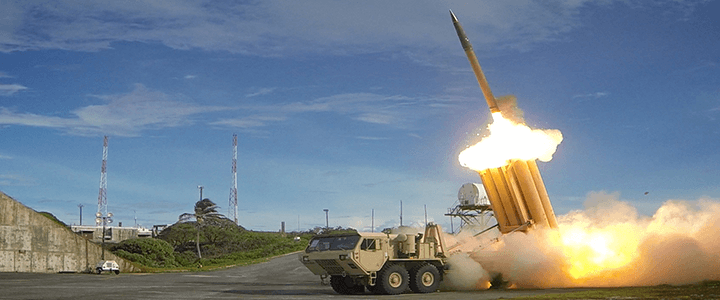While we were all distracted by the saga of Donald Trump, Jr. and the Russian lawyer, the Department of Defense’s Missile Defense Agency hit another milestone Monday, using the Terminal High Altitude Area Defense system to intercept an intermediate range ballistic missile for the first time. According to the MDA, the THAAD system has now successfully destroyed targets in all 14 operational tests.
The THAAD interceptor launched from the Pacific Spaceport Complex-Alaska and hit a “threat-representative” IRMB launched from an Air Force C-17 over the Pacific Ocean.
A SIGNIFICANT IMPROVEMENT OVER PREVIOUS SYSTEMS
The Army’s existing Ground-based Midcourse Defense system is built by Boeing with assistance from other large contractors such as Raytheon. The system, which is based at Fort Greely, Alaska and Vandenburg Air Force Base, Calif., and is designed to hit intercontinental ballistic missiles, has been successful in only 55 percent of its intercept tests since 1999. It most recently intercepted a target missile in a May 30 test.
THAAD is built by Lockheed Martin and operated by soldiers from the 11th Air Defense Artillery Brigade from Fort Bliss, Tex. with support from other services. The missileers of the 11th ADA Brigade were the first to shoot down a ballistic missile when they intercepted an Iraqi Scud missile with a Raytheon Patriot missile during Operation Desert Storm in 1991.
But unlike the Patriot system and other Cold War-era missile defense systems which use explosions to defeat their targets, GMD and THAAD use kinetic interceptors. Described as “hitting a bullet with a bullet,” kinetic interceptors use only their own mass and momentum to destroy a target on impact.
THE PRODUCT OF DECADES OF DEVELOPMENT
Both the GDM and THAAD owe their existence to the Strategic Defense Initiative begun under President Ronald Reagan in 1983. Widely derided as “Star Wars” fantasy at the time, the SDI revived a dormant U.S. missile defense effort by envisioning a multi-layered defense of ground- and space-based interceptors to provide a shield against the Soviet Union’s nuclear threat. The military had been working on anti-missile defense almost as long as missiles had existed, and fielded several variants of the Nike missile system in the 1950s to provide protection to American cities.
The SDI Organization was established to lead the program in 1984 and although many of the programs initial ideas came to fruition, the organization remained. It was renamed the Ballistic Missile Defense Organization in 1994 and again renamed the Missile Defense Agency on January 2, 2002. The U.S. formally withdrew from the 1972 Anti-Ballistic Missile Treaty in June of 2002, clearing the way for more rapid development of interceptors like THAAD.
In addition to doubts over its technical feasibility and ability to defend adequately against a large-scale nuclear attack, critics argued that SDI was a destabilizing development that would encourage a first-use of nuclear missiles, either by the Soviets before the system was complete, or by an emboldened United States, who believing in the power of the shield, would launch a nuclear strike without fear of retaliation.
We hear those same arguments today from those who argue that the placement of a THAAD battalion in the Republic of Korea would encourage North Korean dictator Kim Jong-un to use his nascent nuclear capability preemptively, and in Chinese fears that the U.S. would somehow be encouraged to launch a nuclear attack against them.
These critics argue from the perspective of those whose leaders have absolute power to decided when and where to employ their militaries, particularly their nuclear forces. Despite all the fears over the unpredictability (and some say, instability) of President Donald Trump, the U.S. system has sufficient checks and balances to prevent such wanton abuse. And no matter what the hardcore left argues, the nation’s leadership, Democrat and Republican, is guided by the principle of defending freedom, not a preemptive doctrine of victory against all enemies at all costs.
Our military expeditions not withstanding, we’ve largely demonstrated that strategic restraint for 72 years. The world should welcome THAAD and other missile defense systems for what they are: a protection against rogue actors like North Korea and Iran, and not as a threat to stability.




